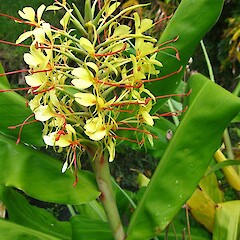Hedychium gardnerianum
Common name
wild ginger, kahili ginger
Family
Zingiberaceae
Flora category
Vascular – Exotic
Structural class
Herbs - Monocots
NVS code
The National Vegetation Survey (NVS) Databank is a physical archive and electronic databank containing records of over 94,000 vegetation survey plots - including data from over 19,000 permanent plots. NVS maintains a standard set of species code abbreviations that correspond to standard scientific plant names from the Ngä Tipu o Aotearoa - New Zealand Plants database.
HEDGAR
Conservation status
Not applicable
Habitat
Terrestrial. Forests, regenerating forest, streamside and alluvial forest, forest light gaps and gullies. Prefers moderate to high fertility, not found in very dry or rocky areas.
Detailed description
Non-woody perennial to 2 m tall, ginger-scented. Rhizomes massive, taro-like, close to ground surface, long, shallow rooted, much-branched, growing over each other, forming deep beds. Rhizome segments 4 x 10 cm, each producing an aerial stem usually annually. Stems to 2 m, erect, soft, unbranched, thickening to short pinkish collar at base. Leaves alternate, 20-45 x 10-15 cm, shiny, slightly hanging. Flowerhead 25-45 cm tall with many flowers, Jan-Mar. Flowers lemon-yellow with conspicuous red stamens, fragrant. Fruiting spike with fleshy orange fruits, 15-20 mm long, containing many bright scarlet seeds.
Similar taxa
Similar to H. flavescens (yellow ginger), Zingiber spectabile (cullinary ginger) and Canna spp. but the leaves of H. gardnerianum are much broader than other gingers, and the tall flower heads of H. gardnerianum make it distinctive from Canna spp.
Flowering
January, February, March
Flower colours
Red/Pink, Yellow
Life cycle
Perennial. The flower is hermaphrodite (Timmins & MacKenzie 1995). In addition to regenerating from seed, it reproduces vegetatively from short stout rhizomes. Up to 100 seeds are produced per flowerhead. Seed is dispersed by birds, in particular tuis and blackbirds (Landcare Research 4/93). Rhizome fragments and seed are also spread by humans and water and soil disturbance.
Year naturalised
1940
Origin
India Himalayan region
Reason for introduction
Ornamental
Tolerances
Tolerant of frost and moderate shade (Seedlings require semi-shade) and slightly tolerant of drought, requires medium to high soil fertility. Flourishes on damp silt. Physical damage results in multiplication of rhizome pieces.
National Pest Plant Accord species
This plant is listed in the 2020 National Pest Plant Accord. The National Pest Plant Accord (NPPA) is an agreement to prevent the sale and/or distribution of specified pest plants where either formal or casual horticultural trade is the most significant way of spreading the plant in New Zealand. For up to date information and an electronic copy of the 2020 Pest Plant Accord manual (including plant information and images) visit the MPI website.









